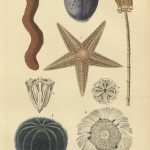…but there is more than one species of bone-eating worm! The genus Osedax (Annedida: Siboglinidae) are common features of dead whale falls and obtain their nutrition through bone-penetrating roots that host symbiotic bacteria. Whale bones don’t have chance! The first species was described in 2004 and since then 3 more have been described (O. rubiplumus, O. frankpressi, O. mucofloris, and O. japonicus). A new study by Braby et al. identifies 4 more new species. The 4 tentative species are both morphologically and genetically distinct (based on mtCO1). Interestingly, they may be temporally and spatially segregated on whale falls. The males are typically small and parasitic on the females. A single female may have an entire of harem of males (>100). Now to introduce the species occurring on whale falls off the central California coast.
- O. frankpressi is about 23mm in length with palps that are red with a white stripe. The roots are robust. So far only known from 2893m.
- O. rubiplumus is the big girl of the bunch at a whopping 59mm (a little over 2 inches) in length. Most of the other species are near 14-25mm. The palps are brilliant red and thus the latin name. The roots are long and branched. This species is known from 1820-2893m and probably an early colonizer of whale-falls. Its depth range may be limited by the Oxygen Minimum Zone occurring at 800-1200.
- ‘Orange collar’ has…well…an orange collar. The roots are robust and lobate. Smallish at 18mm. Depth is shallow near 385m.
- ‘Spiral’ is so named for distinctive corkscrew posterior end. Interestingly the species has no palps. The roots are also unique in being filamentous. It is only known from a site at 2893m. It appears to grow only on degraded bone fragments buried in sediment and thus probably a late colonizer.
- ‘Ol’ Yeller’ is so named for the prominent yellow collar. Known from 385m and tends to be small at ~18mm. The roots are robust and lobate.
- ‘Rosy’ is named for her red palps. The species is only known from 1018m. The roots like O. rubiplumus are long and branched. Formed dense aggregations on lateral processes of whale vertebrae in just 2 months.












there’s a typo here: “O. rubiplumus is the big girl of the bunch at a whopping 59cm ”
it’s mm not cm…. you scared me
Nice catch! Fixed. That might give someone a shock!